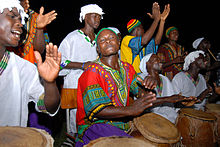Ghana is an ethnically diverse country that is predominantly influenced by the ancient Kingdoms of the Akan. Ghanaian culture is a mixture of the cultures of its peoples, predominantly Akan, Ewe, Ga-Adangbe, and Dagomba, with the Akan being dominant. Ghana's cultural diversity is most evident in cuisine, arts, and clothing.
Sports
Football is the most popular sport. The national men's football team is known as the Black Stars, with the under-20 team known as the Black Satellites. Ghana has participated in many championships including the African Cup of Nations, the FIFA World Cup and the FIFA U-20 World Cup. In the 2010 FIFA World Cup, Ghana became the third African country to reach the quarter-final stage of the World Cup after Cameroon in 1990 and Senegal in 2002.[114] There are several club football teams in Ghana that play in the Ghana Premier League and Division One League, both managed by the Ghana Football Association.
The country has also produced quite a few quality boxers, including Azumah Nelson a three-time world champion, Nana Yaw Konadu also a three-time world champion, Ike Quartey, and Joshua Clottey.[113]
Arts
Textiles are very important in Ghanaian culture. These cloths are used to make traditional and modern attire. Different symbols and different colours mean different things. Kente is probably the most famous of all the Ghanaian cloths. Kente is an Akan ceremonial cloth hand-woven on a horizontal treadle loom. Strips measuring about 4 inches wide are sewn together into larger pieces of cloths. Cloths come in various colours, sizes and designs and are worn during very important social and religious occasions. In a cultural context, kente is more important than just a cloth. It is a visual representation of history and also a form of written language through weaving. The term kente has its roots in the Twi wordkɛntɛn which means a basket. The first kente weavers used raffia fibres to weave cloths that looked like kenten (a basket); and thus were referred to as kenten ntoma; meaning basket cloth. The original Asante name of the cloth was nsaduaso or nwontoma, meaning "a cloth hand-woven on a loom"; however, "kente" is the most frequently used term today. Variations of narrow-strip cloths similar to kente are also woven by the ethnic group Ga. It is also popular throughout the African diaspora.
Ghana has been recognized on the international level through several artists, including the Kane Kwei Carpentry Workshop and Eric Adjetey Anang, who create the famous design coffins.
Music
The music of Ghana is diverse and varies between different ethnic groups and regions. Ghanaian music incorporates several distinct types of musical instruments such as the talking drum ensembles, goje fiddle and koloko lute, court music, including the Akan atumpan, the Ga kpanlogo styles, and log xylophones used in asonko music. The most well known genres to have come from Ghana are Afro-jazz which was created by Ghanaian artist Kofi Ghanaba.[115] and its earliest form of secular music is called highlife. Highlife originated in the late 19th century and early 20th century and spread throughout West Africa. In the 1990s a new genre of music was created by the youth incorporating the influences of highlife, Afro-reggae, dancehall and hiphop. This hybrid was called Hiplife. Ghanaian artists such as R&B and soul singer Rhian Benson and highlife singer Kojo Antwi have had international success.
Dance
Ghanaian dance is as diverse as its music. Each ethnic group has their own traditional dances and there are different dances for different occasions.
There are dances for funerals, celebrations, storytelling, praise and worship etc. Some of these dances include Adowa, Kpanlogo, Azonto, Klama, and Bamaya.
Media
The media of Ghana is one of the most free in Africa. Chapter 12 of the 1992 Constitution of Ghana guarantees freedom of the press and independence of the media, while Chapter 2 prohibits censorship.[116] Post independence, the government and media often had a tense relationship, with private outlets closed during the military coups and strict media laws that prevent criticism of government.[117] The media freedoms were restored in 1992, and after the election in 2000 of John Agyekum Kufuor the tensions between the private media and government decreased. Kufuor was a supporter of press freedom and repealed a libel law, though maintained that the media had to act responsibly.[118] The Ghanaian media has been described as "one of the most unfettered" in Africa, operating with little restriction on private media. The private press often carries criticism of government policy.[119] The media were vigorous in their coverage of the 2008 Ghanaian presidential election, and the Ghanaian Journalists Association (GJA) praised John Atta Mills on his election, hoping to foster a good media-government relationship.[120]




No hay comentarios:
Publicar un comentario